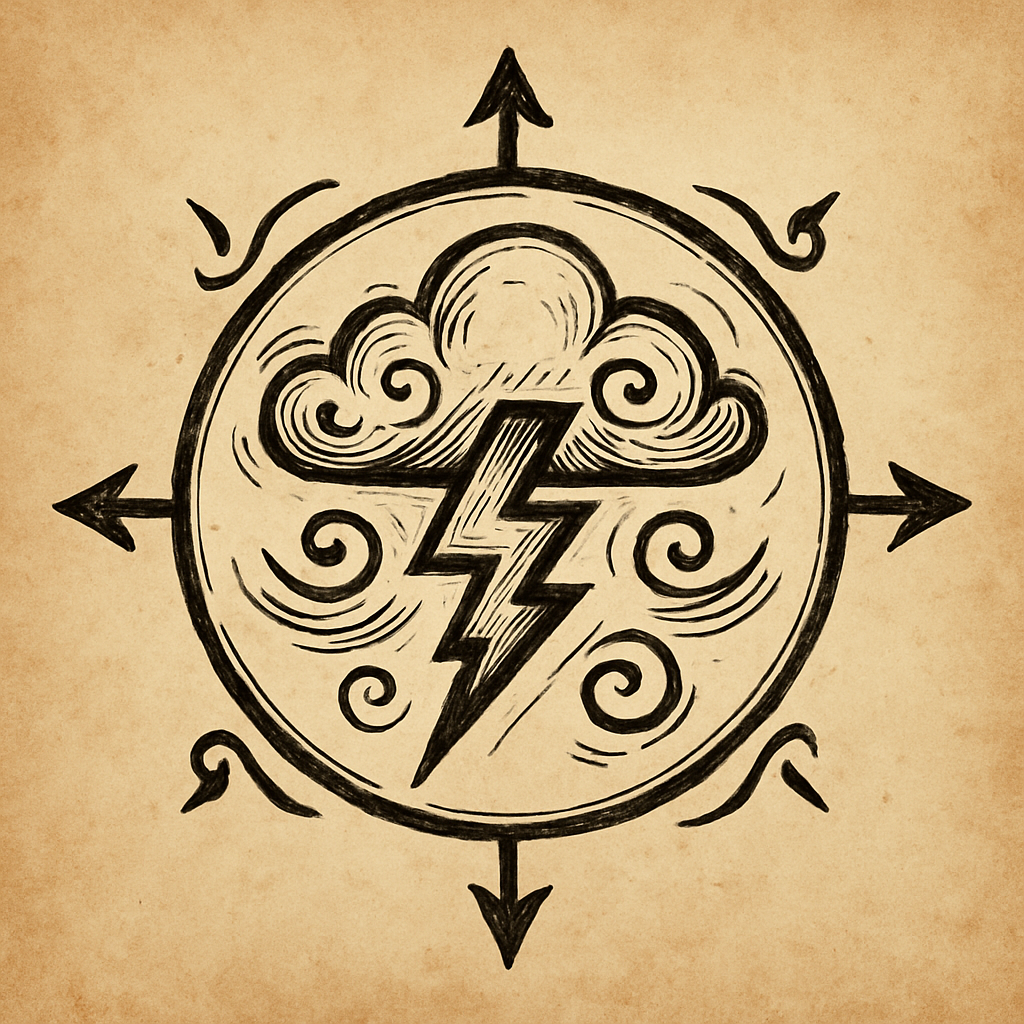Sevast
Change is not a storm—it is the sky itself.
Description of the Church
The Church of Sevast, known as The Stormwright’s Creed, honors the power and majesty of the sky in all its moods—from calm breezes to roaring thunder. Followers do not worship Sevast to tame him, but to understand, respect, and harmonize with the ever-changing sky.
The Church teaches that weather reflects the emotions of the world, that storms cleanse as well as destroy, and that lightning is the finger of divine judgment. Temples are built high—in mountain passes, cliff faces, or atop tall towers—open to the wind and sky. Rituals are often conducted outdoors, even in dangerous weather, to show humility before nature’s vastness.
Sevast is seen as a divine arbiter, a distant yet vigilant force who punishes arrogance and blesses those who walk humbly beneath the heavens.
Core Beliefs
- The sky sees all, and it remembers.
- Weather is the voice of the divine, not to be controlled but honored.
- Lightning is truth, sudden, clear, and impossible to ignore.
- Change is constant, and balance must be maintained between peace and fury.
- Those who walk with the storm must be strong, but never prideful.
Religious Structure
The Stormwright’s Creed is a network of sky-temples and weather-monasteries.
- The Eye Above – A prophet who interprets celestial signs and guides seasonal doctrine, usually chosen after surviving a storm alone in the open.
- Cloudcallers – Clergy who perform rites for rain, wind, and storm-reading. They often serve farmers or sailors.
- Skymarks – Traveling priests who chart weather patterns and deliver omens.
- Thunderwards – Devoted followers trained in sky magic and storm-walking, often warriors.
- Mistborn – Initiates who live in silence above the clouds to learn humility and awe.
Rituals and Practices
- The Storm Vigil – A night spent exposed to the elements to commune with Sevast’s spirit.
- Calling the Breath – A ritual to ask for wind, breeze, or clear skies before travel or war.
- The Lightning Trial – A rite where initiates stand in an open field during a storm to prove faith and courage.
- The Rainblessing – Ceremonial thanks after life-saving weather or rain.
Followers
- Sailors, farmers, and travelers, whose lives depend on the skies.
- Storm mages and elementalists, seeking raw celestial power.
- Watchers and omens-readers, who interpret the sky’s warnings.
- Ascetics and sky-monks, finding clarity in elevation and isolation.
Temples
Temples are built at great height, exposed to the wind and sky, often topped with metal rods to attract lightning. Features include:
- The Windhall, an open chamber with echoing acoustics for sky-chanting.
- The Lightning Pillar, where sacred storms are called down.
- The Cloud Archive, a weathered stone map tracking generations of storm cycles.
Conflict and Controversy
- Rivalry with Zedast , whose waters both nurture and erode the sky’s domain.
- Respected by Valistal's followers, who admire Sevast’s impartial judgment.
- Opposed by Vohrmahz's cult, who seek to silence nature’s song.
- Divided between:
- Weatherwrights, who try to predict and guide storms, and
- Wyrdwinds, who believe all weather should be accepted without interference.
Relationships with other gods
Central Architect: Sevast was imagined in awe—the god in the clouds, the breath before the storm, the strike that cannot be reasoned with. He is not order, but pattern; not rage, but change. He was born from the fear and reverence mortals hold for the sky—its beauty, its fury, and its silence. He reminds all things that nothing stays the same.
Relationship with Zedast (water): Interwoven. Rain is Zedast’s voice spoken through Sevast’s breath. They shape the world together—Zedast flowing, Sevast driving. Storms are seen by some as ritual dances between the two. Yet when floods come, they sometimes war.
Rivalry with Elaith (sun): Temperamental opposition. Elaith is constancy; Sevast is motion. Where Elaith declares truth, Sevast questions it with thunder. Both see themselves as bringers of clarity—but one through stability, the other through upheaval.

Symbol: A lightning bolt striking downward from a cloud ringed by wind-swirls and four directional arrows.
Meaning: Judgment from above, motion, and the impartial balance of the storm.
Areas of Concern: Sky, Weather, and Lightning
Edicts: Ride the winds of change. Speak boldly and strike quickly. Respect the storm and its silence. Adapt or be swept away.
Anathema: Resisting change or disrupting natural weather patterns
Divine Attribute: Strength or wisdom
Devotee Benefits:
Cleric Spells: 1st: gust on wind, 3rd: lightning bolt, 5th: control water
Divine Font: Harm
Divine Sanctification: Can choose holy or unholy
Divine Skill: Survival
Domains: Air, destruction, might, protection
Favored Weapon: Spear



Comments